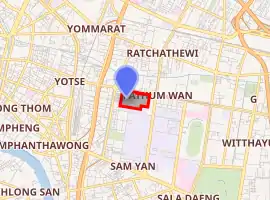National Stadium (Thailand)
The National Stadium of Thailand (Thai: สนามกีฬาแห่งชาติ or กรีฑาสถานแห่งชาติ) is a sports complex located in Pathum Wan District, Bangkok. Founded in 1937 with the construction of Supachalasai Stadium (สนามศุภชลาศัย; RTGS: Supphachalasai), its main venue, the complex has since expanded and now consists of multiple stadia and sporting facilities.
 | |

| |
| Full name | Supachalasai National Stadium |
|---|---|
| Location | Wang Mai, Pathum Wan, Bangkok, Thailand |
| Public transit | BTS National Stadium |
| Owner | Chulalongkorn University[1] |
| Operator | Chulalongkorn University |
| Capacity | 19,793 [2] |
| Surface | Grass |
| Construction | |
| Built | 1937 |
| Opened | 1938 |
| Expanded | 1941 |
| Architect | Department of Physical Education |
| Tenants | |
| Thailand national football team (selected matches) | |
History

It is used mostly for football matches. It served as the main stadium for the 1966, 1970, and 1978 Asian Games. It was also used for the 2007 AFC Asian Cup, but only for one game (Oman v Iraq in Group A). The stadium is easy for spectators to get to as it is served by the BTS Skytrain which stops at the 'National Stadium BTS station' right next to the stadium.[3]
The stadium is a single tier construction which is uncovered on three sides. A plain but effective roof covers the main-stand side. Although there is a running track, the tribunes are immediately adjacent to it so spectators are not as far from the action as they are at the newer Rajamangala Stadium. Spectator comfort was increased in 2007 with the addition of red bench seats to the previously bare concrete steps on the three open sides.[4]
Thai league clubs often play at the Suphachalasai in Asian competitions as their own stadiums do not meet Asian Football Confederation criteria. However, it is now rarely used by the national team who usually play at the Rajamangala National Stadium. Other stadiums in Bangkok include the Thai Army Sports Stadium, the Thai-Japanese Stadium and Chulalongkorn University Stadium.
- Entertainer Michael Jackson performed 2 concerts there during his Dangerous World Tour on 24 and 27 August 1993 in front of 140,000 in attendance.[5]
Stadium Facility
Suphachalasai Stadium
Suphachalasai Stadium is the majority part of the National Stadium. It is the multi-purpose stadium with track and field for athletic purposes, as well as a partial roof on one of its side. With its capacity of 19,793, the stadium is being used to hold important matches such as the Thai FA Cup and Thai League Cup.
Thephasadin Stadium
Thephasadin Stadium was constructed in 1965 for the use in 1966 Asian Games as the Hockey venue, hence its original name, Hockey Field. It was renamed in 1983 in memorial of Sanan Thephasadin na Ayutthaya, considered the Father of Thai Football. With its capacity of 6,378 seats, it was retired from being the hockey stadium.
Jindarat Stadium
Jindarat Stadium, constructed after the Pacific War, was formerly used as the outdoor stadium for medium-level sporting events and practicing purposes. It was originally named Ton Pho Stadium, but was renamed in 1983 in memorial of Jindarat (Jamlong Sawat-chuto), former director of the Office of Sports and Recreation Development.
Wisutamol Pool
Wisutamol Pool was constructed in 1961 under the term of director Kong Wisutamol. It was the Olympic-size swimming pool with two sides of stands, used for the competition and general practices. Originally named the Olympic Pool, it was renamed in memorial of the director Wisutamol who organized the construction.
Nimibutr Stadium
Nimibutr Stadium, opened in 1963 is an indoor stadium used for sports including boxing, badminton, gymnastics, futsal, basketball and handball.
Jhanthana-Yingyong Gymnasium
Jhanthana-Yingyong Gymnasium was built in 1965.
Notes and references
- https://www.bangkokbiznews.com/news/detail/832910
- "สนามกีฬาศุภชลาศัย". SATC (in Thai). Archived from the original on 2017-12-03. Retrieved 2017-01-16.
- https://www.fourfourtwo.com/th/features/aacchehluueaekhkhwaamthrngccham-80-pii-suphchlaasay-kabnaakhtchuengairkhamtb
- http://www.smmsport.com/m/article.php?a=9149
- Dangerous Tour
See also
External links
![]() Media related to Suphachalasai Stadium at Wikimedia Commons
Media related to Suphachalasai Stadium at Wikimedia Commons
| Preceded by Shahid Shiroudi Stadium |
AFC Asian Cup Final Venue 1972 |
Succeeded by Azadi Stadium |
| Preceded by Government Stadium |
AFC Women's Championship Final Venue 1983 |
Succeeded by Mong Kok Stadium |